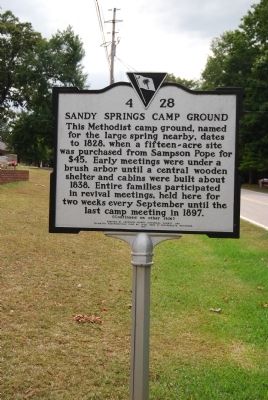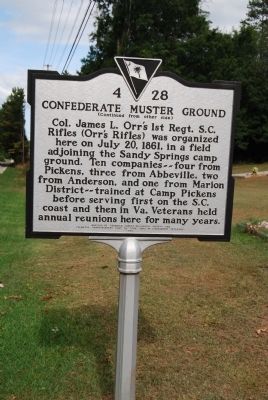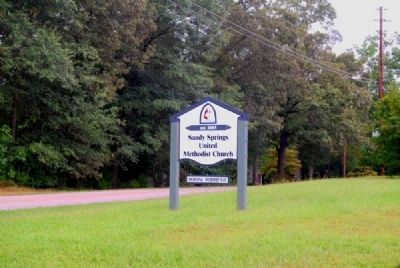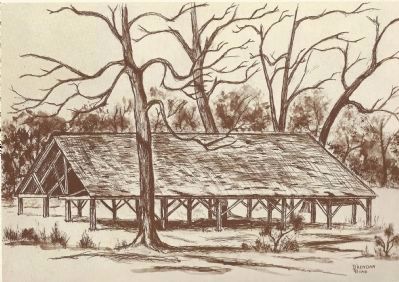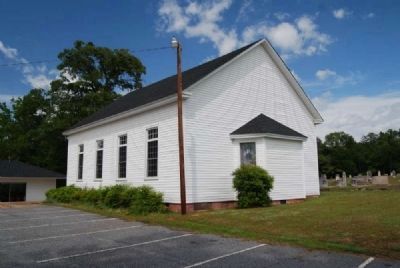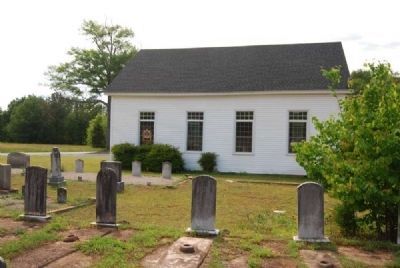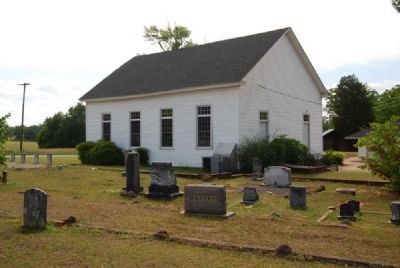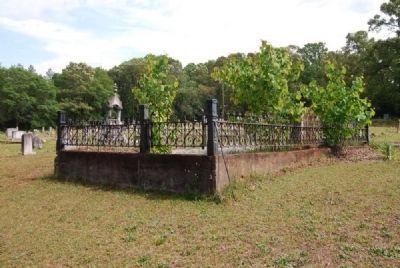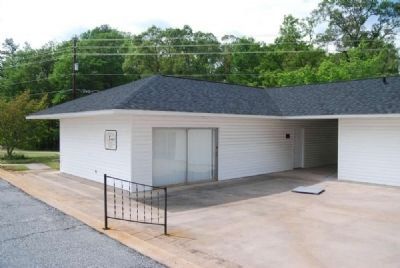Sandy Springs in Anderson County, South Carolina — The American South (South Atlantic)
Sandy Springs Camp Ground / Confederate Muster Ground
Erected 1999 by Anderson County Historical Society and Palmetto Sharpshooters Camp No. 1428, Sons of Confederate Veterans. (Marker Number 4-28.)
Topics and series. This historical marker is listed in these topic lists: Churches & Religion • Military • Notable Places • War, US Civil. In addition, it is included in the Sons of Confederate Veterans/United Confederate Veterans, and the South Carolina, Anderson County Historical Association/Society series lists. A significant historical month for this entry is July 1803.
Location. 34° 35.846′ N, 82° 44.759′ W. Marker is in Sandy Springs, South Carolina, in Anderson County. Marker is on Millwee Creek Road. Touch for map. Marker is in this post office area: Sandy Springs SC 29677, United States of America. Touch for directions.
Other nearby markers. At least 10 other markers are within 5 miles of this marker, measured as the crow flies. Joseph B. Douthit (approx. 2 miles away); Lebanon Baptist Church (approx. 3˝ miles away); Richard W. Simpson (approx. 3.7 miles away); Tanglewood Mansion (approx. 3.8 miles away); Dr. Don C. Garrison (approx. 3.9 miles away); Woodburn Plantation (approx. 3.9 miles away); Woodburn Historic House (approx. 4.1 miles away); Thomas Green Clemson (approx. 4.1 miles away); Barnard Elliott Bee (approx. 4.1 miles away); Clement Hoffman Stevens (approx. 4.1 miles away).
Also see . . .
1. Sandy Springs. Sandy Springs is an unincorporated community in Anderson County, South Carolina, United States. (Submitted on August 27, 2008, by Brian Scott of Anderson, South Carolina.)
2. 1st South Carolina Infantry. Regimental history. (Submitted on September 3, 2008, by Craig Swain of Leesburg, Virginia.)
Additional commentary.
1. Two Mayors of Sandy Springs
Camp meetings having given way to "tent meetings" and "revivals" during the past generation, the grounds became the property of W.K. Moore who was the postmaster for some twenty years and also a major of Sandy Springs in 1940 when the small town gained wide notice as having two mayors who, having been elected by equal ballot, continued to serve jointly, ably and amicable without pay to save further election expenses. (Source: Sketches of Anderson County, The Anderson Tricentennial Committee, 1969)
— Submitted August 27, 2008, by Brian Scott of Anderson, South Carolina.
2. Arbor at Sandy Springs Camp Ground
From 1828 until 1879, Sandy Springs was the center of great spiritual camp meetings in the South. From the middle of September until the first snow as many as three hundred Anderson County residents at a time would gather to take part in the 'good time' camp meetings, to pray,
and to 'hear the Gospel preached and shouted with authority.'
About 1800 the community had been settled by pioneers, mostly Methodists, who had picked the spot because of the spring bubbling out through white sand (unusual in this area of red clay hills) which furnished cool, clear water and gave the town its name. In those days a natural source of good drinking water was vital to the location of a homestead or a community. The fifteen acre tract for the camp ground was bought from Samson Pope for forty-five dollars in 1828, being selected mainly because of its nearness to an ample "sandy spring" and to the Methodist church building. The original log church built in 1803 stood until the 1860s when it was replaced with a wooden structure. The log church was at the north corner of the Camp Ground and there were lots around the area where some families 'tented' during the entire length of the meetings. (Source: Anderson County Sketches, The Anderson County Tricentennial Committee, 1969.)
— Submitted January 10, 2009, by Brian Scott of Anderson, South Carolina.
3. Sandy Springs Camp Meeting
In the early days of the nineteenth century camp meetings were a popular form of revivals and they were held not alone by Methodists, but by Baptists and
Presbyterians as
well. The Methodist churches of Ruhamah and Providence were famous for their camp meetings. Those at Sandy Springs have made the most lasting impression on the community. In 1828 the Methodist congregation at that place bought from Sampson Pope fifteen acres of land for 45 dollars, the same upon which the Methodist Church now stands. It was at once neatly laid off in small lots contained in three rows surrounding a center square on which an arbor was erected. Fifty cents was paid for the privilege of putting up a tent on one of these lots, and after a time permanent shelters of of wood were erected. In 1838 Edward Jefferson Britt hewed out the timber and built an arbor in which to hold the camp meetings. They continued until 1897. The present church was built in 1868, and a flourishing town has grown up around the old house of worship.
It was at Sandy Springs that Orr's Regiment of Rifles was organized July 1861. And there for many years after the war was over the survivors help their annual reunions. With that regiment during the war was almost every man of the Sandy Springs neighborhood who could shoulder a gun.
The great Sandy Springs camp meeting began on the third Sunday in September, and continued abut two weeks. Very many people became converted at these big revivals. There were four preaching hours every day and Mr. Satterfield, a Christian who felt that if he could neither preach nor pray, he could call the people to service, for many years sounded the trumpet which summoned the people to worship. (Source: Traditions & History of Anderson County by Louise Ayer Vandiver.)
— Submitted September 16, 2012, by Brian Scott of Anderson, South Carolina.
Credits. This page was last revised on October 16, 2020. It was originally submitted on August 27, 2008, by Brian Scott of Anderson, South Carolina. This page has been viewed 2,905 times since then and 78 times this year. Photos: 1, 2. submitted on August 27, 2008, by Brian Scott of Anderson, South Carolina. 3. submitted on September 16, 2012, by Brian Scott of Anderson, South Carolina. 4. submitted on January 30, 2012, by Brian Scott of Anderson, South Carolina. 5, 6, 7, 8, 9. submitted on September 16, 2012, by Brian Scott of Anderson, South Carolina. • Craig Swain was the editor who published this page.
